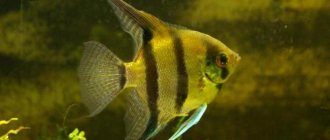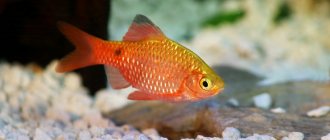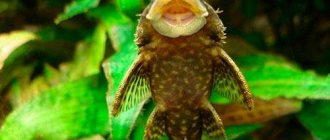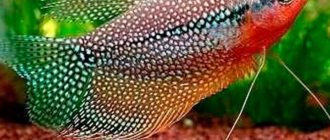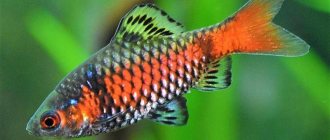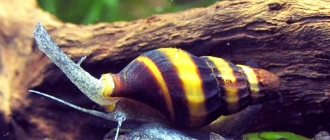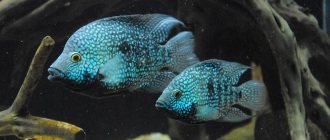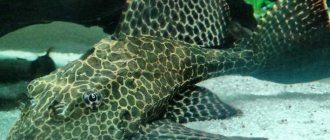Description and general information
Catfish girinocheilus or, in other words, Chinese algae eater is an ornamental aquarium fish from the carp family, a favorite of many aquarists. A medium-sized fish, bright in color, it gained its popularity due to its hard work, the most tireless and conscientious, clearing the home pond of excess algae. Another name for this fish is the algae-eater catfish golden girinocheilus (chanterelle).
In nature, it is found in bodies of water characterized by strong currents and a lot of algae and driftwood at the bottom, mainly in East Asia and China. The fish is native to Vietnam, Thailand, Laos, and Cambodia. Algae eaters can migrate, depending on the time of year they can be found in different places, even in flooded rice fields. In the east, this fish is allowed to be caught for sale. As a result, in some countries it is on the verge of extinction and is listed in the Red Book. Belongs to the carp family.
This fish loves places with an abundance of pebbles and algae.
The first mention of gyrinocheilus dates back to 1883. In 1956, it was first introduced to Germany and then began to spread to aquariums all over the world.
The increased popularity of this type of fish is associated with the appearance of a large number of decorative aquariums with rich vegetation inside in the form of lower algae. Dealing with them on your own is quite troublesome, time-consuming, and often simply futile. And here the indispensable helpers for maintaining cleanliness in the aquarium - gyrinoheilus - come into play. After all, their distinctive feature is precisely the cleaning of the walls of aquariums, stones, and decorations from growing algae.
Appearance and size
There are several color options, the most common being yellow sides and brown-gray backs. Often the fish Girinocheilus has a longitudinal dark stripe, which in some places can be interrupted and look like spots. The scales have a dark edge, resulting in a barely noticeable mesh pattern on the body. The fins are yellow or gray. The caudal fin is two-lobed, with small dark dots. Males have brighter colors than females. They do not swim very well, despite a developed swim bladder; they move mainly due to sudden movements of the body. And the speed of movement is lightning fast, making them quite difficult to catch from the aquarium.
Looking at Gyrinocheilus aureus up close, it’s easy to notice the scales.
The aquarium fish reaches a length of 15 cm, and in the wild it is about 30 cm. The body is low, elongated, the back is slightly arched, the abdomen is wide and flat. The sucker mouth with hard horny plates is located in the lower part of the head. There are no mustaches, but there are spines around the mouth. The gills have special openings through which the fish breathes without using its mouth. With the help of suction cups, it holds firmly on hard stones and snags in the fast flow of the river. From them the fish cleans algae, phytoplankton, detritus, and bacterial film. Belongs to the carp family.
Behavior
The hardworking and diligent fish removes algae from the stones and glass around it. At a young age, these are peaceful, calm individuals and can live in packs. As they grow up, they become aggressive. They zealously defend their territory from competitors. They can live peacefully with enough food in the aquarium, in this case we mean algae. But as soon as it feels that the food supply is depleting, it turns into a dominant, mercilessly chasing other fish around the tank. They can chase and harm other fish, especially smaller ones. They attach themselves to the sides of fish with their suction cup mouth and cause serious injuries.
Found both in the surface layers of water and at the very bottom, they lead a predominantly diurnal, active lifestyle.
Note!
The younger the individual, the more actively it cleans the aquarium. Adults are often lazier.
These golden fish are not called aquarium cleaners for nothing.
Lifespan
The lifespan of Girinocheilus is quite long. With proper care, an aquarium fish can live more than 10 years.
Habitat
Most often it is found in clean, running water, in reservoirs whose bottom is well illuminated by sunlight and covered with numerous algae. They choose mountain rivers, fast-flowing streams with a lot of pebbles, gravel, and boulders at the bottom. They spend most of their time on hard surfaces. Flooded tree roots are used as natural shelters.
Types of Gyrinocheilus
The most common species of aquarium representatives of Gyrinocheilus are golden specimens. Natural colors are rare. The species on sale are those that are bred on special farms, and not brought from natural bodies of water. Girinocheilus differ only in color; in character and conditions of detention, they are absolutely identical.
Ordinary
Gyrinocheilus is ordinary - the color of the body is from yellowish to olive in color with black dots on the sides, the edges of the scales are dark. The standard size of an aquarium fish is 10-12 cm.
Siamese
Girinocheilus siamese - the color of the body is yellowish-orange. It can easily be confused with the Siamese algae eater, but it has a black stripe along its body and its mouth has a different structure.
Gold and yellow
Gyrinocheilus golden - the color of the body is golden, sometimes there are dark spots on the sides. The yellow algae eater has a more uniform color.
Gyrinocheilus common
Girinocheilus siamese
Yellow type
Albino
These representatives have a white body with a pinkish tint without any other markings. The main natural varieties of Gyrinocheilus look exactly like this.
Marble
Marbled Gyrinoheylus has a light brown color with dark spots. The scaly pattern is clearly visible. There are black dots on the translucent tail. Fish with this coloring are also found in nature. The color of the body resembles milk chocolate, and the dark spots are located so that they resemble a marble pattern. Lyre-shaped tail.
Hyrinocheilus albino
Girinocheilus golden, which is noticeable by its non-uniform shade
Marbled subspecies
Maintenance and care
The content of Gyrinoheylus is not the most difficult. The main thing is to ensure cleanliness, temperature, and oxygen saturation. Once a week it is necessary to refresh approximately 20% of the liquid from the total volume of the aquarium with clean water.
Aquarium
Most often, an aquarium with 100 liters of water is used for young individuals, and 200 liters for adults. The calculation should be made logically - 40-50 liters of water per fish. It is advisable to purchase an aquarium with a lid, since active Gyrinocheilus can jump out of it. You need to release the fish into a habitat prepared in advance with a balance of water temperature, light, etc.
Equipment
The main equipment you will need to care for these fish is:
- A water purification system that will create an intense current. It is better to use external filters. They are equipped with different filter materials and provide better filtration.
- Compressor for oxygen supply. You need to use a good, powerful device, since the lack of oxygen and the presence of nitrogen compounds in the water have a detrimental effect on the fish. A cluster of aquarium inhabitants near the surface of the water indicates a lack of oxygen in the home pond.
- Water heater. The temperature in the aquarium should be at least 20 degrees. Otherwise, algae eaters will be slow and sickly. If the aquarium is located in a room with constant heating, then additional heating of the water may not be necessary. To cool water in the summer, containers with frozen water are often used.
Water parameters
To maintain Gyrinocheilus, it is necessary to ensure and maintain optimal aquarium water parameters:
- temperature – 22-28 °C;
- water hardness – 5-19 °dH;
- water acidity – 6.0-8.0 pH.
Girinocheilus likes cool water with a moderate pH
Plants and substrate
Absolutely any plants can be planted in an aquarium with Girinocheilus. If the fish is provided with a sufficient amount of plant food, it will not touch the planted plants, even with tender leaves. There should be as many plants as possible; fish perceive and use them as natural shelters; it is better to plant them in dense thickets.
Fact!
Ferns, mosses, anubias, and cryptocorynes are most often planted. Experienced aquarists also plant more demanding species: water lilies, ludwigia, Lindernia, and Aciotis.
Priming
The bottom should be covered with small pebbles, gravel or soil with sand.
Scenery
For decorations you can use whatever you like, there are no restrictions. Algae eaters can use grottoes or pots, sunken ships, and broken jugs as shelters. Wooden driftwood and flat stones at the bottom are suitable, which perfectly complement the aquarium and make it similar to the natural habitat.
Shelters
There should be as many shelters as possible so that the fish can hide in them. This way they can show more natural behavior.
Lighting
Lighting is very important when caring for this type of aquarium fish. It is necessary to provide the brightest possible lighting so that algae grows vigorously inside the aquarium, on its walls and on decorative elements.
Gyrinoheylus will definitely like such bright lighting
Feeding
In the wild, it feeds mainly on zooplankton, insect larvae and algae. The fish are quite omnivorous. The main food is algae and food of plant origin - cucumbers, green peas, cabbage, blanched zucchini, scalded lettuce and spinach leaves. Among animal feeds, it feeds on tubifex, bloodworms, barkworm, shrimp meat and others. They feed near the bottom, so dry food should be in the form of granules, tablets and other sinking types of complementary foods.
It is important to feed your fish in a balanced manner; if only animal feed is used, the fish may become obese.
When purchasing dry fish food, you should pay attention to both the expiration date and shelf life. It is better not to buy food in bulk, since its storage conditions are not known, and if they are violated, pathogenic flora may develop in it.
You should feed them every day, but not in large portions, so that they do not stop eating algae. Fish need a fasting day at least once a week.
When feeding, you can follow the menu:
- 1 day – dry granules or tablets;
- Day 2 – live food;
- Day 3 – algae;
- Day 4 – heat-treated vegetables.
Important!
Gyrinocheilus do not eat filamentous algae; they are not suitable for them.
This food is quite suitable for picky Gyrinocheilus.
Compatibility
Girinocheilus are small, active, diurnal fish that live in all layers of water. They are mainly found at the very bottom or near surfaces from which algae can be cleaned. By nature they are loners.
Young individuals are quite peaceful and calm; they can be kept in common aquariums with other fish, but they must be spacious in order to avoid conflicts with other individuals.
Adults have a harmful character, they become aggressive, zealously defend and guard their territory, and are jealous of food. Cute fish can terrorize weaker relatives to death. It is allowed to keep them in groups of at least 5 pieces. Then the fish build a kind of hierarchy and their level of aggression decreases somewhat.
When choosing neighbors for Girinocheilus, small, peaceful, fast fish that live primarily in the upper layers of water are best suited. Such as botia, barb, catfish corydoras, zebrafish, rasbora and others.
In addition, it is better to stock all the fish first, and then the algae eater. Otherwise, he will perceive the entire aquarium as his territory. It is not at all recommended to house Girinocheilus with large, calm, slow fish. If an individual has an aggressive character towards any representatives of the fauna, it is better to keep him alone.
Since Gyrinocheilus is a fairly peaceful fish, it gets along well with its fellows
Compatibility with other fish
Aquarium cleaner catfish are rarely kept separately from other species. Usually they are placed with other fish. In such conditions, ancistrus exist perfectly as aquarium orderlies: the fish cleans growths from various surfaces.
They also proved themselves to be excellent neighbors. Catfish have a friendly, calm character, only occasionally allowing themselves to chase other “residents” of the aquarium. For this reason, it is not recommended to keep ancistrus together with slow, clumsy fish that are not protected by scales.
It is not allowed to add ancistrus to sacbranch catfish and cichlids.
Reproduction
Breeding Gyrinoheilus catfish is almost impossible, since it is a troublesome business and requires a lot of labor. They are bred on specialized farms using hormonal injections, which are quite expensive and difficult to buy. But sometimes experienced aquarists take up breeding.
Sex differences
The sex of Gyrinocheilus can be determined during the spawning period. Females are visually larger than males, and in males a fatty tubercle forms on the head and the body color becomes brighter.
Spawning
Gyrinocheilus reaches sexual maturity in the second year. For breeding, you will need a special spawning aquarium of at least 200 liters with a separator mesh at the bottom and a filter that creates an average water flow rate. It is advisable to install the filter so that when spawning, the eggs are distributed over different parts of the mesh and washed with the current. It is also important to ensure good aeration, medium lighting of the aquarium and plant plants with large leaves.
For spawning, a female with a large belly and two males are chosen. One adult female lays 3000–4000 eggs. The caviar has a pale pink color, measuring about 0.6-0.8 mm in diameter. After 30 minutes, the eggs will reach a size of 2.5-3 mm in diameter.
When breeding fish at home, the female is given hormonal injections twice, before spawning and during landing, in order to provoke the female to spawn and get healthy offspring.
To successfully breed Gyrinocheilus, you need to maintain specific water parameters in the aquarium:
- temperature – 24 °C;
- water hardness – 4-5 °dH;
- water acidity – 6.8 pH;
- daily water renewal in the amount of up to 10% of the aquarium volume.
Breeding gyrinocheilus is not difficult, the main thing is to follow the basic rules
The incubation period is from 24 to 48 hours. Immediately after spawning, the female is removed from the spawning area; after fertilization of the eggs and the appearance of the larvae, the males are also caught. The eggs must be carefully examined to eliminate dead eggs; they will be covered with a characteristic white coating.
The first food for the fry is crushed plant food, live dust, egg yolk, and after a week, brine shrimp and rotifers are added.
Eggs and fry are sensitive to pathogenic viruses and bacteria; you need to carefully monitor the cleanliness of the spawning tank and add methylene blue to the water.
For your information!
Young fry have a peaceful disposition and feed on short, young and soft algae.
Breeding and reproduction
If there are no predatory fish in the aquarium, then reproduction of ancistrus can occur even unnoticed by the owner.
The best conditions for mating are to keep one sexually mature pair in the reservoir, that is, those who have reached the age of 8-12 months. It is not worth keeping several males together for breeding, as they will fight and eat the fry.
In nature, the chain catfish breeds during the rainy season. Therefore, for successful spawning in an artificial reservoir, it is advisable to imitate it. To do this, it is enough to lower the water temperature to +20...+21 °C and update the volume of liquid daily by a third or even half.
Females spawn in shelters. Therefore, it is worth placing a ceramic grotto on the bottom with a fairly spacious interior.
The male thoroughly cleans the territory before mating. Then the female takes a shelter, in which after some time she lays eggs and leaves them. The male fertilizes the clutch and from that time on, all care for the offspring falls on him.
The female should be removed immediately after spawning, since the male actively protects the offspring even from the mother and can attack and even kill her.
The future father takes care of the offspring for a week (sometimes 5 days is enough), regularly fanning the clutch with fins. During the entire period of maturation of the fry, he does not leave the clutch even to eat. At the same time, it creates aeration, an influx of clean water and removes dead eggs.
As soon as the first fry begin to hatch from the eggs, the male should also be removed.
If the female has laid eggs on the glass, they are carefully removed with a blade and transferred to a dark grotto or under a snag. The male is not removed.
Diseases and prevention
This type of aquarium fish does not have any specific or characteristic diseases. They are susceptible to the same diseases as other representatives of the fauna, such as ichthyophthyriasis, abdominal dropsy, fin rot and other bacterial and viral diseases. They occur due to improper care or maintenance of pets, and are also adopted from other fish added to the aquarium without prior quarantine.
If suspicious spots begin to appear on the fish, then you should take a closer look at Gyrinocheilus
That is why it is important to monitor the cleanliness of the aquarium, and to release new neighbors to the rest of the individuals after temporarily being in a separate container. At the same time, you can add methylene blue to it for prevention and monitor the condition for 2-3 days.
Fish that feed on live food can get sick from the bacteria that it often contains. When purchasing such food, you need to carefully look at its condition, remove bad larvae and worms, process the rest and store at the right temperature.
The main diseases to which gyrinocheilus are susceptible due to poor-quality conditions of detention:
- Excess food leads to obesity and the fish have a bloated belly. It is necessary to strictly follow the feeding schedule and regimen, diversify the diet and feed crushed food.
- Nitrogen poisoning or oxygen starvation from contaminated water. The water in the aquarium must be periodically checked for nitrite and ammonia content using special tests. If there is an excess of harmful impurities, a quarter of the water in the aquarium needs to be replaced and air conditioner added to neutralize chemical compounds.
- Infectious and parasitic diseases in fish are manifested by loss of appetite, color, ruffled scales, lethargy, and the appearance of plaque on the body. Only specialists can determine what exactly the fish is sick with. The medicine can be purchased at a veterinary clinic or pet store. Antibacterial drugs with a broad spectrum of action are sometimes used.
Treatment of aquarium fish for viral or bacterial diseases is best done in a community aquarium, since most likely all fish will be infected. If possible, it is better to do without serious chemicals and antibiotics, so as not to damage the planted higher plants. It is recommended to keep the water at about 32 degrees and vigorously blue the water for the first few days. In this way, minimal damage will be caused to the plants, and the fish will recover. The most common sources of viral or bacterial infections among aquarium fish are loose food or new individuals immediately released into the general aquarium.
Adviсe
To make caring and keeping your fish enjoyable, you need to follow a few simple tips:
- If the fish begin to feast on higher plants, it is worth reviewing and adjusting the diet. Perhaps they do not have enough plant food. Damage to the scales of neighboring individuals indicates a lack of live food.
- When overfed, the fish stop feeding on algae thickets, and they begin to actively grow. In this case, the amount of feed should be reduced. Moreover, these fish are prone to overeating and obesity, so you should carefully monitor portion sizes.
- To always provide Gyrinocheilus with plant food, you can take plants and stones, place them in a separate container with water and place them in a place illuminated by the sun's rays. Thus, algae will grow in it for feeding pets.
- To preserve the offspring during the spawning period, you need to add antifungal drugs to the aquarium water.
- The aquarium should be placed in a safe place on a sturdy base or stand.
- During feeding, it is necessary to carefully examine the fish and count the number of individuals.
Feeding
When the algae runs out, Gyrinoheilus catfish will begin to starve. However, you should know that the gyrinocheilus catfish does not feed on algae alone. Hyrinoheilus catfish can eat plant foods: algae, catfish tablets, zucchini, cucumbers, lettuce, etc. as well as animal food, various live and frozen foods lying on the bottom: bloodworms, coretra, tubifex, grindal, aulophorus. Young Gyrinoheilus catfish (as well as Ancistrus and Siamese algae eaters) prefer plant foods and are therefore considered the best aquarium cleaners at this age.
Reviews
Girinocheilus is an interesting, beautiful, and most importantly, useful aquarium fish that can be kept in large tanks. Due to its capricious nature and frequent problems with neighboring fish species, it may be inferior in popularity to other representatives of the fauna. But you shouldn’t be afraid to have such an active resident, because the aquarium in which Gyrinocheilus lives will always be much cleaner than other tanks.
Would you like to buy such a fish for your own aquarium? Share in the comments!
What to feed in the aquarium?
Both live and dry food are excellent as food for sticky catfish. The favorite delicacy of these fish is green algae, in search of which they spend most of their time. Also, cleaner catfish have the habit of finishing food after other fish. To prevent Ancistrus from destroying all the algae in the aquarium, the pet should be fed with nettle and cabbage leaves, as well as some vegetables, for example, cucumbers and zucchini.
cucumbers
In addition, it is recommended to place real driftwood in the aquarium. First you need to prepare it, namely, rinse it properly and boil it in a saline solution. By “processing” the snag with suction cup mouths, pets will receive the fiber they need.


